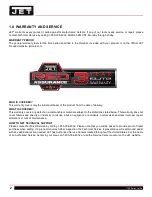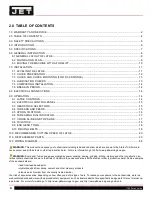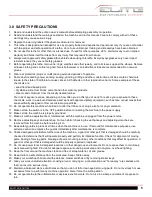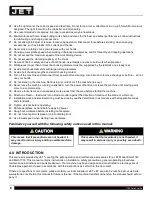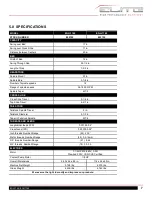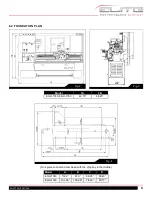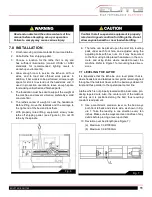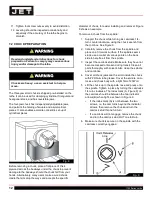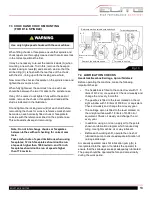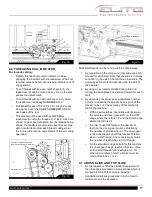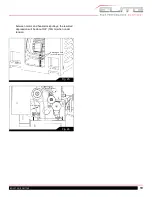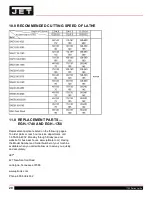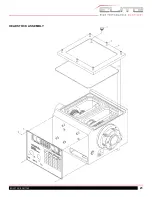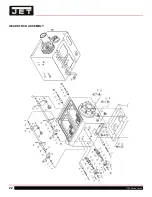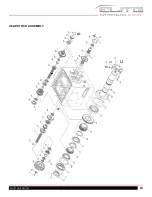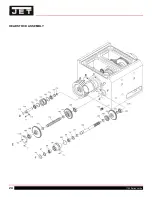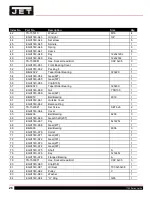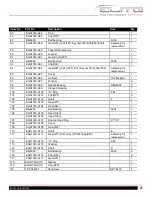
12
1700 Series Lathe
11. Tighten foot screw nuts evenly to avoid distortion.
12. Leveling should be inspected occasionally, and
especially if the accuracy of the lathe begins to
diminish.
7.2 CHUCK PREPARATION
Read and understand all directions for chuck
preparation. Failure to comply may cause serious
injury and/or damage to the lathe.
Chucks are heavy; use an assistant to help re-
move.
The three-jaw scroll chuck is shipped pre-installed on the
lathe. It can be used for clamping cylindrical, triangular and
hexagonal stock, and has reversible jaws.
The four-jaw chuck has independently adjustable jaws,
and permits the holding of square and asymmetrical
pieces. It also enables accurate concentric set-up of
cylindrical pieces.
Fig. 8
Before removing a chuck, place a flat piece of thick
plywood across the bedways under the chuck to prevent
damage to the bedways should the chuck fall from your
hands. Alternatively, many users make a wood chuck
cradle that sits atop the ways and accepts the specific
diameter of chuck, for easier installing and removal. Figure
8 shows an example.
To remove a chuck from the spindle:
1. Support the chuck while turning six camlocks 1/4-
turn counterclockwise, using the chuck wrench from
the tool box. See Figure 9.
2. Carefully remove the chuck from the spindle and
place on a firm work surface. If the spindle seems
stuck, use a mallet at various points on the back
side to help free it from the spindle.
3. Inspect the camlock studs. Make sure they have not
become cracked or broken during transit. Clean all
parts thoroughly with solvent. Also clean the spindle
and camlocks.
4. Cover all chuck jaws and the scroll inside the chuck
with #2 lithium tube grease. Cover the spindle, cam-
locks, and chuck body with a light film of 20W oil.
5. Lift the chuck up to the spindle nose and press onto
the spindle. Tighten in place by turning the camlocks
1/4 turn clockwise. The index mark (A, Figure 9) on
the camlock should be between the two indicator
arrows (B) when tight, as shown in Figure 9.
•
If the index mark (A) is not between the two
arrows, i.e. the cam turns beyond the indicator
arrows, then remove the chuck and turn the
camlock stud IN one full turn.
•
If a camlock will not engage, remove the chuck
and turn the camlock stud OUT one full turn.
6. Make sure chuck is secure on the spindle with the
camlocks correctly engaged.
Fig. 9
Содержание 892100
Страница 21: ...21 EGH1740 EGH1760 HEADSTOCK ASSEMBLY ...
Страница 22: ...22 1700 Series Lathe HEADSTOCK ASSEMBLY ...
Страница 23: ...23 EGH1740 EGH1760 HEADSTOCK ASSEMBLY ...
Страница 24: ...24 1700 Series Lathe HEADSTOCK ASSEMBLY ...
Страница 28: ...28 1700 Series Lathe GEARBOX ASSEMBLY ...
Страница 29: ...29 EGH1740 EGH1760 GEARBOX ASSEMBLY ...
Страница 33: ...33 EGH1740 EGH1760 APRON L H ASSEMBLY ...
Страница 34: ...34 1700 Series Lathe APRON L H ASSEMBLY ...
Страница 39: ...39 EGH1740 EGH1760 4 WAY TOOL POST ...
Страница 41: ...41 EGH1740 EGH1760 SADDLES ASSEMBLY ...
Страница 42: ...42 1700 Series Lathe SADDLES ASSEMBLY 2 ...
Страница 45: ...45 EGH1740 EGH1760 BED AND SHAFTS ASSEMBLY ...
Страница 48: ...48 1700 Series Lathe END GEAR ASSEMBLY ...
Страница 50: ...50 1700 Series Lathe MAIN MOTOR ASSEMBLY ...
Страница 52: ...52 1700 Series Lathe CABINET AND PANEL ASSEMBLY FRONT MOVEABLE CHIP TRAY OPTIONS ...
Страница 56: ...56 1700 Series Lathe CONVENTIONAL TAILSTOCK ASSEMBLY ...
Страница 58: ...58 1700 Series Lathe STEADY REST ASSEMBLY ...
Страница 62: ...62 1700 Series Lathe 892156 5C COLLET CLOSER OPTIONAL ...
Страница 64: ...64 1700 Series Lathe 892157 TAPER ATTACHMENT OPTIONAL ...
Страница 68: ...68 1700 Series Lathe 12 0 WIRING DIAGRAM ...


